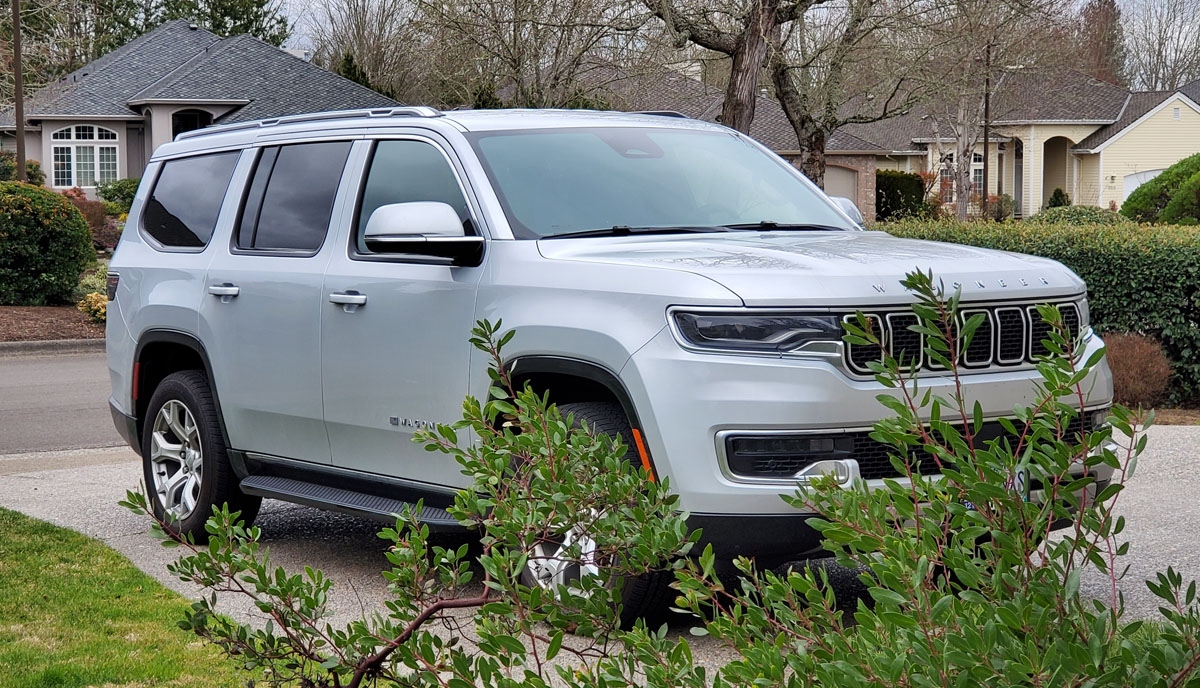I tend to purchase cars that are either new or slightly used, and then drive them for a long time before replacement. My almost nineteen-years-old Ford Expedition has served me well since I purchased it new in 2004. I have been contemplating replacing it lately and finally pulled the trigger a few days before Christmas. I purchased a new 2022 Jeep Wagoneer. I discussed before when it is OK to buy a new car.
During the purchase process I stumbled across some information that saved me an extra $5,000 on the deal. The dealership knew about these offers, but didn’t share them willingly. I stumble onto them myself. I thought others would benefit from hearing my story.
I also included other tips I used to get a better price when negotiating a car purchase.
Buy at the end of the month
Those who sell cars often receive commissions. These commissions are frequently based on sales for the month. As the month comes to an end, they are hungrier to make a sale to boost their commission. This is getting to be common knowledge enough that the salesman working with me told me outright that he was hungry for one more sale before the month ended and would make me a good deal.
The reality I faced was not as he portrayed it. He was not giving me a good deal, he was making me believe he was giving me a good deal assuming I already knew about his monthly commission.
Buy at the end of the year
Just as the end of the month is an incentive for the sales force to boost their commissions, the end of the year is a time when the dealership is wanting to get last year’s models off the lot. It looks bad to still have 2022 models on the lot in 2023. The buyer might wonder why this particular car did not sell last year. And the dealer also wants to get more cars with 2023 on the sticker.
So I was looking to buy a 2022 model a few days before 2023. There is no incentive for the dealer to drop the price to get rid of a 2023 model in 2022. The dealer will have a full year to get a higher price on a 2023 automobile.
Pit dealers against each other
Since a dealer only makes money if you buy a car from them, they will drop the price to get a sale to stop you from buying from another dealer.
When I started shopping, I didn’t know exactly which large FWD SUV I wanted to buy as there were several good choices. After some online research I narrowed it down to a few good choices. Then I went to the dealers and looked at the cars I was interested in.
Do not start by taking a test drive. You don’t want to fall in love with a car and not check out the other options. Every dealership offered me a test drive. I told each of them I wasn’t ready for a test drive yet as I was looking at the different options first. After I narrowed it down, then I would test drive the few good ones that were left.
Once I have very specific cars in mind, I let the dealers know which cars I’m truly interested in. Now the dealers are more eager to make a deal with me, so they can make the sale.
Search for the car throughout your region
Once I narrowed my search down to three different models, I started looking at which features each model had that I wanted. For example, the Wagoneer I was looking at came in Series I, II, III, and Grand.
I began by comparing what was offered in each package level. I was able to rule out the series I and the Grand. So I knew I was looking for a Series II or III Wagoneer. I did the same for the Ford Expedition and the Chevy Tahoe.
I then looked at the inventory of every Jeep dealer in a 300-mile radius to see what was available and at what price. Jeep makes this very easy, much more so than the other searches. With Ford, I needed to go individually to every dealership online. I found the Jeeps all on one website.
Now I was armed with the knowledge that there were three Jeep Wagoneers sitting on nearby lots that I was willing to buy, and I knew the dealer’s asking price for each. One dealership was three blocks from my home and the other, with two Jeeps I liked, was a four-hour drive away. Looking into the Ford Expedition inventory I found one I would purchase four hours away. There was a single Chevy in the running one hour away.
Search for which dealerships are offering sales
Each dealership offers different deals. They also offer specific cars on sale now and then to get people into their lot. One person told me about a car they saw on sale in the paper for $14,000. It was exactly what she was looking for, so she went to the lot to purchase it. The sales person showed her the car and told her it was $20,000.
When the customer showed the sales person the newspaper ad sale price, they agreed to sell it for $14,000. Even though that car was a loss leader to bring people into the lot, the dealership still tried to sell the car at full price.
During my search I found one dealership offering way more off the Manufacturer’s suggested retail price (MSRP) than the nearby dealer offered. This dealer was also sharing the specifics of the dealer incentives they were using to make the discount.
This is where I learned that there were incentives available that the local dealership had not mentioned to me. This gave me a chance to negotiate my best deal with them and then subtract the special dealer incentives on top of that.
There were three special offers for low cost financing. Since I would be paying cash for my car, these incentives would not help me.
There was also a $1,000 cash back deal offered in select regions. My region was not one of them.
Then I hit pay dirt with the Jeep Conquest Incentive. Jeep was offering $3,500 off the price of select models (the Wagoneer was one of them) if the buyer was already driving a competitor’s car (I was driving a Ford). My local dealer had not initially mentioned this incentive.
Check the manufacturer’s website for deals
When I was doing my research on the different types of Wagoneers at the Jeep Manufacturer’s website, a deal popped up on my screen. If I bought a Wagoneer in the next 30 days, Jeep would give me a coupon worth $1,500 off the price of the car.
The local dealer never mentioned this offer either.
Pick one salesperson at each dealership
Now it was time to make a deal. I had found five cars in the state I was willing to purchase. One Ford Expedition four hours away, One Chevy Tahoe one hour away, two Jeep Series III Wagoneers four hours away (about $6,000 more than the Series II), and one Jeep Wagoneer Series II a few blocks from my house.
I was partial to giving the sale to the local dealer if I could get a good deal. I had been back to the lot a few times and took the car on two test drives. I always went back to the same salesperson and he knew me by name.
Now I was seriously ready to make a deal. I transferred the money needed for the purchase into my checking account so I could write a check and leave with the car if we could make a deal.
I told him I had narrowed my search to five very specific cars. He wanted to know which they were as he might be able to get them for me and avoid my need to travel four hours. (He really just wanted to know what he was competing against) I gave him the specific cars and the dealerships that had them.
He did some research and was not able to get any of the other cars transferred to his lot for the deal. He knew I was ready to buy so we were now ready to negotiate. He also knew what he was competing with which did give him some advantage, but also made it more urgent for him to make a deal or I would go elsewhere.
My negotiation
The salesperson already knew I was paying cash. He went to the finance manager to come up with their first offer. It was not a good deal, only a thousand off the MSRP and they offered me $1,000 to trade in my Ford.
I already had done a Kelley Bluebook search of my used car and knew I could sell it myself for $4,000 – $5,000. I was not willing to sell it to them for $1,000.
I told my local dealer that the dealer four hours away was advertising their car for about $6,000 below MSRP. I said if they could reduce the price of the car in their lot by $6,000 I would buy from them and not make the drive to purchase the other car, which did have some added features I would like.
He went back to the finance manager for a new offer. This time the trade in offer was removed and added the Jeep Conquest Incentive of $3,500. He told me I qualified for it since I was purchasing his Jeep to replace a Ford, and I could get the deal even if I did not trade it in. I was wondering why they didn’t include the Conquest Incentive in the first deal since he clearly knew I was replacing a Ford.
He told me the Conquest Incentive was the reason the other dealership was offering such a low price. So they were willing to give me that deal as well.
I took their written offer and told them I would go home to think about it and contact the other Jeep dealer to see what their best price is as well as the Ford and the Chevy options which were all acceptable to me.
He called me later to tell me he had dropped the price another $1,000 to help me with my decision.
I then told him I would go with his deal and save myself the trouble of my wife and I driving four hours to purchase one of the other cars and returning home in two cars.
We had a deal. Then I told him to draw up all the papers and I would come in in the morning to finalize the sale. I then dropped my other coupon on him. I told him I also had the Jeep coupon for $1,500 off if I bought the Wagoneer within the next 30 days. There was a bit of silence on the other end of the line. Then he asked if I had the coupon code. I gave him the code and he said he would apply it and have everything ready in the morning.
He clearly knew about this extra $1,500 off coupon, but never mentioned it. I wonder if that $1,500 cut into his commission or if he was saving it for a final offer if I was going to go elsewhere.
Conclusion
Timing your car purchase for the end of a month, or even better the end of the year makes a dealership more eager to make a deal. Especially when the purchase is the outgoing model year. Using one salesperson who understands you are definitely planning to buy a car in the next few days helps. Also, letting them know you are also interested in very specific cars currently sitting on someone else’s lot is helpful. That got me the extra $1,000 they took off while I was at home deciding. (I also used that tactic when I purchased my grand piano. The dealer knew I was down to his and a competitor’s piano and they each wanted the sale so competed with each other on price.)
Make sure to do your own search for special incentive offers for the car you want, since the dealer doesn’t want you to know about this savings. In my case, the $3,500 conquest incentive and the $1,500 Jeep coupon were $5,000 off the purchase price that the dealer had not told me about, I found them on my own. The dealer did use the $3,500 incentive late in the negotiation process. Although the salesperson clearly knew about the $5,000 I could get off the price he did not volunteer the information. This is a good example of how a little bit of research can save you a lot of money. What other tips can you add?






Cory, Thanks for writing a revealing and eye opening article on the ara of negotiating an auto deal. It seems that in general physicians are embarrased to haggle and spend time in figuring out all the details described by you. I learnt a lot from reading this well written article. It definitely gives me courage and incentive in doing my own research and negotiating a great deal.
Do you know if this is true of U.S. manufactured cars only?
I enjoy reading your blogs.
Deals can be found in any sales encounter no matter the country of origin.